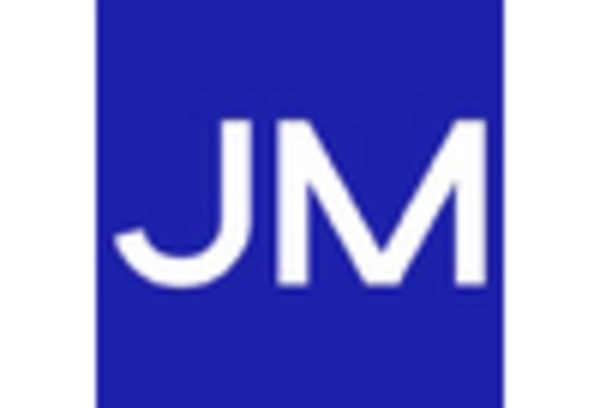Growing Environmental Regulations
The tightening of environmental regulations is influencing the precious metal-catalysts market. Governments are implementing stricter emissions standards, particularly in the automotive and industrial sectors, which necessitate the use of advanced catalytic technologies. For example, the introduction of the Clean Air Act in the US has led to increased demand for catalytic converters that utilize precious metals to reduce harmful emissions. This regulatory landscape is expected to propel the market, as manufacturers seek to comply with these standards. The precious metal-catalysts market is projected to grow by approximately 5% annually as companies invest in technologies that meet regulatory requirements. Consequently, the market is likely to benefit from the ongoing push for cleaner technologies and sustainable practices.
Increasing Industrial Applications
The expansion of industrial applications is a key driver for the precious metal-catalysts market. Industries such as petrochemicals, pharmaceuticals, and electronics are increasingly utilizing precious metal-catalysts for various processes, including hydrogenation, oxidation, and polymerization. For instance, the petrochemical industry relies heavily on catalysts for refining processes, which are essential for producing fuels and chemicals. The market for precious metal-catalysts in the petrochemical sector alone is expected to exceed $10 billion by 2026. Additionally, the pharmaceutical industry is leveraging these catalysts for the synthesis of complex molecules, further driving demand. As industries continue to innovate and expand, the precious metal-catalysts market is likely to experience sustained growth, reflecting the diverse applications of these catalysts across multiple sectors.
Volatility in Precious Metal Prices
Volatility in precious metal prices is a significant factor affecting the precious metal-catalysts market. Fluctuations in the prices of metals such as platinum, palladium, and rhodium can impact production costs and, subsequently, the pricing of catalysts. For instance, the price of palladium has seen dramatic increases in recent years, which has led manufacturers to explore alternative materials or optimize catalyst formulations to mitigate costs. This volatility may also drive innovation as companies seek to develop more cost-effective catalysts that require less precious metal content. The precious metal-catalysts market is likely to adapt to these price fluctuations, with a projected market value of $18 billion by 2028, as stakeholders navigate the challenges posed by changing metal prices.
Technological Innovations in Catalysis
Technological innovations are significantly impacting the precious metal-catalysts market. Advancements in catalyst design and synthesis methods are enhancing the efficiency and effectiveness of precious metal-catalysts. For example, the development of nanostructured catalysts has shown promise in improving catalytic activity while reducing the amount of precious metals required. This not only lowers production costs but also addresses supply chain concerns related to precious metals. The market is projected to reach $20 billion by 2027, driven by these innovations. Furthermore, the integration of artificial intelligence in catalyst development is expected to streamline research and development processes, potentially leading to the discovery of new catalysts that could revolutionize the industry. Thus, the precious metal-catalysts market is poised for growth as these technological advancements continue to unfold.
Rising Demand for Clean Energy Solutions
The increasing emphasis on clean energy solutions is driving the precious metal-catalysts market. As industries strive to reduce carbon emissions, catalysts play a crucial role in facilitating cleaner production processes. For instance, the automotive sector is witnessing a shift towards electric vehicles, which require efficient catalytic converters. This transition is projected to boost the demand for precious metal-catalysts, particularly platinum and palladium, which are essential for reducing harmful emissions. The market is expected to grow at a CAGR of approximately 6% from 2025 to 2030, reflecting the growing need for sustainable technologies. Consequently, the market is likely to benefit from this trend as manufacturers seek to comply with environmental regulations and consumer preferences for greener alternatives..

















Leave a Comment